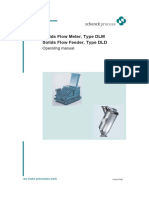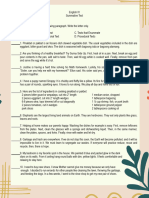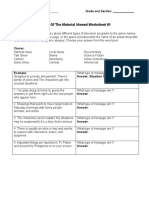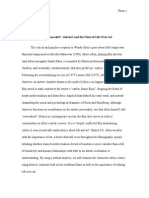Verbal Nonverbal Worksheets
Verbal Nonverbal Worksheets
Uploaded by
Glad FeriaCopyright:
Available Formats
Verbal Nonverbal Worksheets
Verbal Nonverbal Worksheets
Uploaded by
Glad FeriaOriginal Description:
Original Title
Copyright
Available Formats
Share this document
Did you find this document useful?
Is this content inappropriate?
Copyright:
Available Formats
Verbal Nonverbal Worksheets
Verbal Nonverbal Worksheets
Uploaded by
Glad FeriaCopyright:
Available Formats
Department of Education
Batasan Hills National High School
IBP Road, Batasan Hills, Quezon City
ORAL COMMUNICATION IN CONTEXT
VERBAL AND NONVERBAL COMMUNICATION
Name ______________________________________ Section ______________________
Verbal communication refers to an interaction in which words are used to relay a
message. For effective and successful verbal communication, use words to express
ideas which can be easily understood by the person you are talking to. Consider
appropriateness, brevity, clarity, ethics, and vividness when engaging in this type of
communication.
Nonverbal communication refers to an interaction where behavior is used to convey
and represent meanings. All kinds of human responses that are not expressed in words
are classified as nonverbal communication. Examples of nonverbal communication are
stares, smiles, tone of voice, movements, manners of walking, standing and sitting,
appearance, style of attire, attitude towards time and space, personality, gestures, and
others.
Starter:
Choose an answer to the following questions.
1. Which of the following best defines verbal communication?
a. The words and sounds used to convey a message
b. The words used to share an idea.
c. Facial expressions and gestures
d. Eye contact and body positions.
2. Which of the following is a common non-verbal communication?
a. crossed arms b. eye contact c. thumbs up d. all of these are correct
3. The physical gestures and body positions that a person uses are referred to as which of the
following?
a. body language b. micro expressions
c. micro expressions d. none of these are correct
4. Which one of these is a form of verbal communication?
a. shaking hand b. talking professionally c. nodding head
5. What is the purpose of verbal communication?
a. Verbal communication is that when you are communicating, you have to talk
verbally and professionally
b. communicating face to face
c. talking over the telephone
Reinforcer:
Match the headings below to the paragraphs:
a. Your body language
b. The first meeting
c. What type of person are you?
d. What to do with your hands
e. Pay attention to time!
1. ___________________________
Your body language can show what kind of person you are. It can show if you are a busy or a
quiet type and it helps give an impression of whether you are speaking truthfully or not. It can
show how enthusiastic you are and if you are a nice person, someone who will take his or her
work seriously, but also someone who has a sense of humour. Through becoming more aware of
your body language, you can definitely increase your chances of getting a job.
2. _____________________________
An interview for a job is seen as a very important appointment, and arriving even a little late for
your job interview is therefore absolutely unacceptable. Missing the bus or getting stuck in a traffic
jam are poor excuses. It’s much better to arrive much too early than even a little too late!
3. ______________________________
When you arrive, give your name at reception and you will probably be asked to take a seat.
After a while someone will come to lead you to the interview area. Do not jump up immediately
and offer this person a handshake. It is better to let the other person take the lead. Shake hands
firmly, but not too powerfully and look straight at the other person. After this you will be
introduced to the (other) members of the application committee. With each greeting look directly
at the other person, and say your name.
4. ______________________________
Try to show that you are relaxed. You can do this by sitting up straight with your back against
the back of the chair. If you slouch, it might give the impression that you are not interested in the
job. Sitting on the edge of your chair can come across as being a little tense and you might come
across as looking uncomfortable.
5. _______________________________
During a job interview, don’t fold your arms. If you do this, you might look defensive. It is better
to let your hands lie loosely in your lap or place them on the armrests of the chair.
Challenger:
Read the selection below to answer the questions that follow.
When Samuela Tex walked into the office, the office secretary Nisha looked up, met
Samuela’s eyes with a blank look and continued with typing for another two minutes. Then
she looked at Samuela and said, ‘Yes?’ Before Samuela could answer, she held out her palm
to indicate ‘wait’. She then picked up her singing mobile phone to answer a personal call.
1. Mention two non-verbal cues from Nisha which indicate poor customer service.
2. Saying ‘Yes’ in a question tone when serving a customer or client is not appropriate. Why
not? What is the appropriate tone to use?
3. What advice would you give Nisha to improve her customer service?
4. If you were Samuela, what would you do to be served and not be kept waiting?
5. What is the thing that speakers can do to boost their confidence in a presentation?
Prepared by:
TjayG.SalienteJr.
You might also like
- Connotation Denotation in Class WorksheetDocument5 pagesConnotation Denotation in Class WorksheetHương Phạm100% (1)
- Grammar 14 - Verb Tense ConsistencyDocument2 pagesGrammar 14 - Verb Tense Consistencyzarith67% (3)
- Radio Planning Solutions: HTZ FeaturesDocument20 pagesRadio Planning Solutions: HTZ Featuresmavv5455100% (4)
- Basic Communication WorksheetDocument4 pagesBasic Communication Worksheetchelsea albarece100% (2)
- English 5 Worksheet No.4-Quarter 1-AffixesDocument2 pagesEnglish 5 Worksheet No.4-Quarter 1-AffixesRENALIE ALICAWAY80% (5)
- Propaganda Techniques WorksheetDocument1 pagePropaganda Techniques WorksheetEloisa May Lanuza100% (1)
- Exercises On Language RegistersDocument2 pagesExercises On Language RegistersSarah Sophia Aragon100% (2)
- Connotation and Donnation QuizDocument4 pagesConnotation and Donnation QuizNaima Dawson67% (3)
- General and Specific Statements ACTIVITYDocument4 pagesGeneral and Specific Statements ACTIVITYHarold José Rivero Ramos0% (1)
- AffixesDocument15 pagesAffixesAriane del Rosario100% (1)
- Card Catalog TestDocument2 pagesCard Catalog TestCatherine Lagario Renante95% (20)
- COT Figures of SpeechDocument5 pagesCOT Figures of SpeechFeForroOderanNo ratings yet
- 3 Types of Verbs WorksheetDocument2 pages3 Types of Verbs WorksheetCyrene Mae100% (1)
- ENGLISH 7 Test QuestionsDocument2 pagesENGLISH 7 Test QuestionsEvaNo ratings yet
- Name: - Date: - Active or Passive Voice WorksheetDocument2 pagesName: - Date: - Active or Passive Voice WorksheetNarayanamurthy Amirapu50% (2)
- Solids Flow Meter, Type DLM Solids Flow Feeder, Type DLD: Operating ManualDocument20 pagesSolids Flow Meter, Type DLM Solids Flow Feeder, Type DLD: Operating ManualArturMirandaNo ratings yet
- Oral News Report RubricDocument2 pagesOral News Report RubricMa. Bernadette EballeNo ratings yet
- Intimate Casual Formal Consultative FrozenDocument3 pagesIntimate Casual Formal Consultative FrozenGlenmaeNo ratings yet
- Complete The Following Sentences Using Appropriate Verb FormsDocument5 pagesComplete The Following Sentences Using Appropriate Verb FormsMaycel Vega MarmitoNo ratings yet
- Linear and Non Linear Text QuizDocument1 pageLinear and Non Linear Text QuizNica Moku MauringNo ratings yet
- Summative TestDocument2 pagesSummative TestCharles Getape100% (2)
- Third Quarter ExamDocument4 pagesThird Quarter ExamJuna Algones100% (1)
- Poem Recitation RubricDocument1 pagePoem Recitation RubricAmeriza Purpura Tena - Crisostomo100% (2)
- Colloquial-And-Informal-Expressions WorksheetDocument1 pageColloquial-And-Informal-Expressions WorksheetEmanAbdel-Haq50% (2)
- Q1 English Summative Test 2 Type of Texts & AffixDocument2 pagesQ1 English Summative Test 2 Type of Texts & AffixNoribel Daclan100% (1)
- Stress QuizDocument2 pagesStress QuizMayflor GuiyabNo ratings yet
- Activity English 8 On Transitional SignalsDocument2 pagesActivity English 8 On Transitional Signalscharo bao-ilan100% (1)
- Gr6 Alliteration, Assonance, Onomatopoeia, Consonance WorksheetDocument1 pageGr6 Alliteration, Assonance, Onomatopoeia, Consonance WorksheetFema Emper Acosta100% (3)
- Speech ContextDocument8 pagesSpeech ContextkawaiijoonNo ratings yet
- Eng.7 Q4 W2Document11 pagesEng.7 Q4 W2keene Tan100% (1)
- TEST QUESTIONS Oral Comm 1st QuarterDocument2 pagesTEST QUESTIONS Oral Comm 1st QuarterMaia Traje Pamolino100% (1)
- Choral Reading Rubrics: Poor Fair Good ExcellentDocument1 pageChoral Reading Rubrics: Poor Fair Good ExcellentFaithNo ratings yet
- Activity Tone and Mood Part 2Document3 pagesActivity Tone and Mood Part 2Jessica TelegrapoNo ratings yet
- Summative Test in English 7: I. Listening StrategiesDocument2 pagesSummative Test in English 7: I. Listening StrategiesCheeney Keith Burgos100% (2)
- Juncture PracticeDocument6 pagesJuncture PracticeLiezl SabadoNo ratings yet
- Genre 0f The Material WorksheetDocument6 pagesGenre 0f The Material WorksheetVergel Bacares BerdanNo ratings yet
- LP 9 Jan. 21 (Limiting Adjectives)Document5 pagesLP 9 Jan. 21 (Limiting Adjectives)Song Soo JaeNo ratings yet
- Rubrics For Formal Theme WritingDocument2 pagesRubrics For Formal Theme WritingJudith Fetalver100% (8)
- Summative Test in EnglishDocument5 pagesSummative Test in EnglishRichardDumlaoNo ratings yet
- Elements of PoetryDocument13 pagesElements of PoetryStephanie Anaba100% (1)
- Filling Out Forms Information Sheet FormDocument4 pagesFilling Out Forms Information Sheet Formcrisanto_oroceoNo ratings yet
- Quiz With Oral ComDocument3 pagesQuiz With Oral ComHydz Deus Meus ConfugerunNo ratings yet
- Word Formation: Compounding, Clipping, and BlendingDocument3 pagesWord Formation: Compounding, Clipping, and BlendingAida Tovmasyan100% (4)
- Logical ConnectorsDocument2 pagesLogical Connectorsabahmazan50% (2)
- Questions For Read-aThonDocument4 pagesQuestions For Read-aThonShirney Naelga EscabarteNo ratings yet
- Lesson 1-Quiz 1Document3 pagesLesson 1-Quiz 1Kimberly Ann Castro Vitug100% (2)
- Connotation Denotation Worksheet 4Document29 pagesConnotation Denotation Worksheet 4Camilla Babies100% (1)
- Lastquizg 7Document3 pagesLastquizg 7Luis Jade Hambala IbañezNo ratings yet
- Rubrics Newscasting PresentationDocument1 pageRubrics Newscasting PresentationFranjhielyn GolvinNo ratings yet
- English Festival 19Document2 pagesEnglish Festival 19John Mechael Fineza BaynosaNo ratings yet
- Distinguishing Text Type According To Purpose and Language FeaturesDocument26 pagesDistinguishing Text Type According To Purpose and Language FeaturesCarlo Caylaluad100% (1)
- Manuscript Memorized Speech RubricDocument2 pagesManuscript Memorized Speech RubricGlare F Dagyagnao100% (2)
- Memorized Speech RubricsDocument1 pageMemorized Speech RubricsCyrill Mae AlegadoNo ratings yet
- First Summative Test in Grade 7 - English: Riddles Proverbs Tanaga Slang Mood Theme Subject VerbDocument2 pagesFirst Summative Test in Grade 7 - English: Riddles Proverbs Tanaga Slang Mood Theme Subject VerbJeurdecel Laborada Castro - Martizano100% (1)
- What Is Hyperbole and PersonificationDocument6 pagesWhat Is Hyperbole and PersonificationKathlyn PerezNo ratings yet
- Quiz 5 - Types of TextDocument1 pageQuiz 5 - Types of TextLorna T. OrdizNo ratings yet
- NOUNS SummativeDocument4 pagesNOUNS SummativeBarbyann100% (1)
- English Month and Book Month Activities Sy 2023 2024Document9 pagesEnglish Month and Book Month Activities Sy 2023 2024Edson Rovillos100% (1)
- Emphatic Form of The VerbDocument4 pagesEmphatic Form of The VerbCastel Troy Losbaños Pactores100% (1)
- Activity Learning Sheets in Oral - Com - TYPES OF SPEECH CONTEXT - Guinsaugon High SchoolDocument5 pagesActivity Learning Sheets in Oral - Com - TYPES OF SPEECH CONTEXT - Guinsaugon High SchoolCatzMacedaMeekNo ratings yet
- Yourself Which Word Has The Strongest Meaning? Which Has The Weakest Meaning?' Write The WeakestDocument1 pageYourself Which Word Has The Strongest Meaning? Which Has The Weakest Meaning?' Write The WeakestGeorge GiennieNo ratings yet
- Non Verbal Students ActivityDocument3 pagesNon Verbal Students ActivitynovilynesparasNo ratings yet
- LESSON 1 - PR 1Document1 pageLESSON 1 - PR 1Glad FeriaNo ratings yet
- LESSON 1 - PR 1Document1 pageLESSON 1 - PR 1Glad FeriaNo ratings yet
- Ethics in ResearchDocument6 pagesEthics in ResearchGlad FeriaNo ratings yet
- Philippine History QuestionsDocument21 pagesPhilippine History QuestionsGlad FeriaNo ratings yet
- The Pygmalion EffectDocument1 pageThe Pygmalion EffectGlad FeriaNo ratings yet
- The Pygmalion TheoryDocument4 pagesThe Pygmalion TheoryGlad FeriaNo ratings yet
- Written Read Rotten Sung Swim Flew Swam Create Formed Shed Grown Played Leapt Grew Lain Cried Bought Baked Came Climb Crawls Crept Keeps FledDocument2 pagesWritten Read Rotten Sung Swim Flew Swam Create Formed Shed Grown Played Leapt Grew Lain Cried Bought Baked Came Climb Crawls Crept Keeps FledGlad FeriaNo ratings yet
- Combination OF Instrument SDocument25 pagesCombination OF Instrument SGlad FeriaNo ratings yet
- Think of What Would Happen If An Orchestra Had To Perform Without Its Conductor?Document12 pagesThink of What Would Happen If An Orchestra Had To Perform Without Its Conductor?Glad FeriaNo ratings yet
- SimDocument43 pagesSimGlad FeriaNo ratings yet
- Conditioned StimulusDocument2 pagesConditioned StimulusGlad FeriaNo ratings yet
- Sample Question Paper: General Knowledge and Current AffairsDocument4 pagesSample Question Paper: General Knowledge and Current Affairsshano chaudharyNo ratings yet
- Proceedings of 1st ICBAS 2016 18112016Document788 pagesProceedings of 1st ICBAS 2016 18112016suryaning100% (1)
- SNBP WakadDocument4 pagesSNBP WakadAshwini MaliNo ratings yet
- Save Microfinance Private Limited: RatingsDocument4 pagesSave Microfinance Private Limited: RatingsSubhamNo ratings yet
- Fundraising and Grant ApplicationsDocument10 pagesFundraising and Grant ApplicationsNelu StoicaNo ratings yet
- Moc U Medjunarodnim Odnosima - 09 - 10Document103 pagesMoc U Medjunarodnim Odnosima - 09 - 10Nedeljkovic Ex Nikolic AnaNo ratings yet
- News Article SummaryDocument4 pagesNews Article Summaryapi-550030025No ratings yet
- Interiors by Woody Allen - An Academic AnalysisDocument8 pagesInteriors by Woody Allen - An Academic AnalysisbenjaminthunderboltNo ratings yet
- SR Eng Added Seen Passgaes With Key (Telangana)Document7 pagesSR Eng Added Seen Passgaes With Key (Telangana)medigachaithu9No ratings yet
- Talmakkies Case Judgment Over Magistrate 21.11.2023Document17 pagesTalmakkies Case Judgment Over Magistrate 21.11.2023Krash KingNo ratings yet
- World of Animals - Issue 3 "A Tiger's Tale"Document9 pagesWorld of Animals - Issue 3 "A Tiger's Tale"International Fund for Animal WelfareNo ratings yet
- Group Assignment III 12032019Document11 pagesGroup Assignment III 12032019MaiiNo ratings yet
- Makalah Barir Faqih-Danar Andria SMA Trensains Muhammadiyah Sragen S Nas2021Document5 pagesMakalah Barir Faqih-Danar Andria SMA Trensains Muhammadiyah Sragen S Nas2021Muhammad Barir Faqih HermawanNo ratings yet
- Purpose of Listening SkillDocument10 pagesPurpose of Listening SkillAishwarya Suma0% (1)
- 3 CPAN Network Planning and EvolutionDocument20 pages3 CPAN Network Planning and EvolutionsdetransbliNo ratings yet
- SM2ed Teacher - S Resources Worksheet J L3 U9Document6 pagesSM2ed Teacher - S Resources Worksheet J L3 U9Kaung Khant Ko KoNo ratings yet
- Decide To Commit It.": Case of People of The R.P. vs. Pugay No. L-74324 17november1988Document2 pagesDecide To Commit It.": Case of People of The R.P. vs. Pugay No. L-74324 17november1988Ashley Kate PatalinjugNo ratings yet
- Moral Stories For F.ADocument4 pagesMoral Stories For F.AIftikhar Hussain Rizvi76% (29)
- 2021 Europe and Africa Private Capital Compensation SurveyDocument19 pages2021 Europe and Africa Private Capital Compensation SurveyBen SetoNo ratings yet
- Gifted and Talented Presentation (Compatibility Mode)Document16 pagesGifted and Talented Presentation (Compatibility Mode)Sudirman SaadNo ratings yet
- QAQC MONTHLY Slides For TRC SRUS - 07.12.2020 Zaki Check-AmniDocument16 pagesQAQC MONTHLY Slides For TRC SRUS - 07.12.2020 Zaki Check-AmniShahrul Azwan100% (2)
- 6 - Diary of A Wimpy Kid - Cabin FeverDocument228 pages6 - Diary of A Wimpy Kid - Cabin FeverTobith Tobith100% (1)
- Quatation of Incorporation Fees For Incorporate LLP-10,000 Fees For Incorporate Pvt. LTD - 12,000 Fees For Incorporate NGO - 20,000Document3 pagesQuatation of Incorporation Fees For Incorporate LLP-10,000 Fees For Incorporate Pvt. LTD - 12,000 Fees For Incorporate NGO - 20,000Manish JainNo ratings yet
- Mathematics: First Quarter - Week 4Document6 pagesMathematics: First Quarter - Week 4MARIE GRACE APARRENo ratings yet
- Syllabus British Civilization 2014-2015Document3 pagesSyllabus British Civilization 2014-2015Verutza Verra100% (1)
- Capstone Proposal Final Like Medj FinalDocument22 pagesCapstone Proposal Final Like Medj FinalCABABAN, SHAIRA A. STEM2No ratings yet
- SIEMENS Analysis of Financial StatementDocument16 pagesSIEMENS Analysis of Financial StatementNeelofar Saeed100% (1)
- 2010 UMass Lowell GraduatesDocument10 pages2010 UMass Lowell GraduatesNoahBombardNo ratings yet



































































































